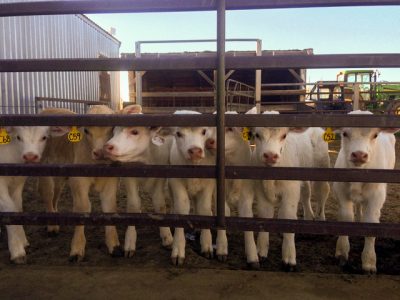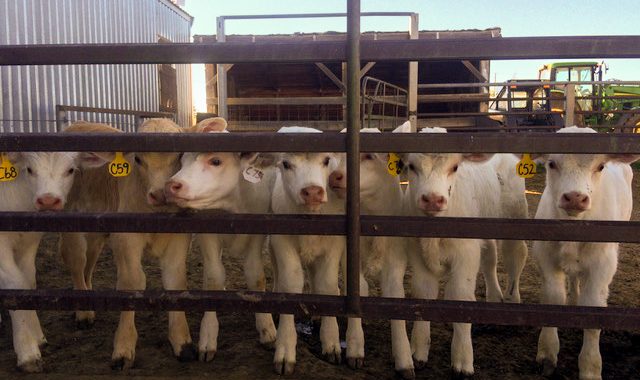
Cattle and/or sheep grazing or chewing their cud is a sign of productive, healthy, ruminant animals.
These ruminants convert Wyoming forages into high-quality, Wyoming-raised beef, lamb, wool, and more. Microbial fermentation in the rumen converts even low-quality forages into high-value end products. These microbes have influences beyond digestion. The microbiome has substantial effects on host performance and long-term implications for production efficiency.
Within the rumen are many microbial species specialized in the breakdown of different feedstuffs into small components that can be utilized by other microbes. Volatile fatty acids (VFA) that serve as a primary energy source for the host (cattle or sheep), microbial protein, and other important factors for the host, are the results of this network of microbial fermentation and breakdown. These fermentation end products provide the host with energy to function – rumen fermentation provides nearly 70 percent (!) of total host energy.
Ruminating on the rumen
Our research efforts target improving efficiency by programming the rumen microbiome. Specifically, we aim to better understand how the rumen microbiome changes as the offspring develops, how maternal factors influence the early colonization of the rumen, and if any early interventions can affect host efficiency into maturity.
Unraveling the complexities of management practices on rumen microbiome
Ruminant livestock are incredibly valuable to our state, country, and world.
Their unique digestive systems and the tiny organisms housed inside are complex. Continuing research to understand how these organisms develop in the rumen and what influences they have on host performance and efficiency is critical.
The rumen microbiome plays pivotal roles in feed efficiency due to the importance of these microbes in the breakdown of feed and generation of energy for the host. Many research projects from our lab and others have showed differences between the high and low efficient livestock in terms of their rumen microbiome.
There is the potential to capitalize on this innate system to improve efficiencies, increase production, optimize health and performance, and have large impacts on productivity of these ruminant livestock.
Wyoming producers are already doing excellent work managing their cows and ewes to produce high-quality calf and lamb crops and optimize the land and forages available. Perhaps we can now begin to also consider the complexity of management influences on the rumen microbiome.
Development of rumen
At birth, the rumen is essentially non-functional and very underdeveloped. The newborn calf or lamb is solely consuming milk, which allows for a more rudimentary microbiome to colonize the rumen early because the complex feedstuffs, which would require a diverse microbiome, are not present. Even so, there appears to be unique microbial profiles in the rumen from immediately after birth, which provides some evidence there may be some microbial colonization of the rumen prior to delivery.
Additionally, the meconium (or first feces) has a unique microbiome, which suggests microbial colonization during gestation. The meconium microbiome is not particularly diverse or robust; nonetheless, there are microbes present in the meconium that also appear in the mature rumen.
These early microbial species are important for proper development of the rumen and establishing the immune system. The microbes will shift dramatically as the rumen develops and the animal matures due to the consumption of more diverse feed types (hay, concentrate, etc.).
Figure 1 shows a plot of the calf rumen microbiome at day 1 (red), 3 (blue), and 28 (orange). Each dot represents an individual calf’s microbiome at that respective age. Each day is distinct from another. Dots clustered tighter together indicate more similarity than those spread farther apart. Day 1 and day 3 dots are more sporadically clustered than day 28 dots, indicating that as the animal matures, the microbiome becomes more consistent and less variable than earlier in life.
How these microbes get into the meconium and early rumen to begin with remains unclear. In humans and mice, some of the main factors that can influence this early colonization are the nutrition status of the mother during gestation, mode of delivery, and the milk/colostrum consumed immediately following birth, among others.
Mothers, breed have strong influence
What can be concluded by the evidence and applied in our laboratory is that there is a strong influence of maternal factors on this early colonization, which means there is potential to “program” the early microbiome via management of the gestating cow/ewe.
This is the aim of our research objectives.
Some of the key maternal factors we have focused on are:
- maternal breed,
- mode of delivery,
- rearing type, and
- maternal gestational nutrition.
The rumen microbiome of Charolais calves and Angus calves differed in terms of overall microbial compositions. These differences in breed actually became more prominent as the animal matured.
Identifying breed differences in the microbiome contributes to the body of literature that emphasizes the influence of host genetics on the rumen microbiome. This may allow for genetic selection and breeding schemes that consider host genotypic influences on the calf microbiome.
Rumen differences in birth deliveries
A study was designed to deliver several calves via C-section, several via natural delivery (vaginal), and after calving another group had their calves removed at 24 hours and raised on a bottle. This alteration in management led to distinct differences in the microbiome, especially in the samples collected earlier in life (day 1, 3, and 28).
Many of the differences caused by changes in mode of delivery or rearing type went away as the animals matured with only tendencies for specific species differences persisting post-weaning.
The C-section calves did not have as “rich” a microbiome as those calves delivered through the birth canal, which can have implications on development of the rumen, immune system, and long-term health of the calf.
These data help us understand what role these maternal factors have in early development and long-term impacts on calf health and performance.
Rumen effects later in life
Not only are we interested in maternal factors and early colonization, but we also want to see the impact these factors might have on feed efficiency later in life. A post-weaning feed test was conducted and residual feed intake (RFI) was calculated from the individual feed intake data generated by the GrowSafe system.
This measure of feed efficiency represents the difference in what animals are actually consuming and what their expected intake was given their metabolic body weight and rate of gain. Interestingly, RFI differed by breed but not by treatment (control, C-section, or bottle). The Charolais calves had a more efficient RFI compared to Angus calves (Figure 2), which is also found in the literature.
The microbiome of these calves were very distinct between feed efficiency class (high vs. low) and breed type. These compositional differences may be used to not only predict efficiency but also to develop targeted supplementation that may alter the microbiome and subsequently lead to improved efficiency.
There is much data for livestock species highlighting the importance of the maternal plane of nutrition during gestation on offspring development and performance; however, there has been little to no data investigating the role relative to the rumen microbiome development in offspring.
Our work shows that cows nutrient-restricted during late gestation had offspring whose rumen microbiome at day 7 were different from calves born to cows fed to requirements. This preliminary data supports our ongoing efforts to understand how maternal nutrition can alter the calf rumen development in terms of the microbiome and have potential impact on performance long-term.
What’s next
The answers are still not clear as to what serves as the source of colonization in the early rumen. There is a strong maternal role, and our investigations in this area continue. Recently, we collected microbial samples from the vagina, amniotic fluid, placenta, and cow rumen to compare to the calf meconium and rumen microbiome. While we do not have these results yet, we are excited to see how different maternal microbiomes may overlap with the early calf gut microbiome.
We will continue to investigate the maternal plane of nutrition and are planning a study this year looking at targeted supplementation on rumen microbiome development in calves. Our studies should provide insights on maternal microbiome during gestation, and also on the early calf rumen microbiome, following those calves to evaluate any long-term impacts on performance and efficiency.
Author: Hannah C. Cunningham-Hollinger, Assistant Professor, Department of Animal Science, can be reached at (307) 766-6530 or hcunnin6@uwyo.edu.
Originally published in the 2020 issue of Reflections, Wyoming Agricultural Experiment Station’s research magazine, http://www.uwyo.edu/uwexpstn/publications/reflections/index.html.





